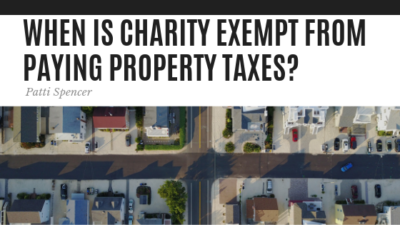When is Charity Exempt from Paying Property Taxes?

Property tax exemption for charities has become a hot topic. In Lancaster City more than 25% of the total value of the assessed property is exempt. Across the country, political subdivisions are being squeezed by the economic meltdown. Tax revenues are shrinking, and the demand and cost for services from the municipalities are ever increasing. When large portions of the tax base are exempted from paying property taxes, a disproportionate tax burden is carried by the non-exempt property owners. Large land-owning nonprofits, such as universities and hospitals, create special challenges for municipalities trying to balance their budgets.
Under the Pennsylvania Constitution, the General Assembly may exempt from taxation “[institutions of purely public charity. . .” But neither the constitution nor legislation includes a definition of a “purely public charity”, so the courts have determined what is meant by those words.
- In 1985, the leading case of Hospital Utilization Project (HUP) v. Commonwealth the Pennsylvania Supreme Court set forth a five-part test for purposes of identifying a “purely public charity”. A purely public charity: advances a charitable purpose;
- donates or renders gratuitously a substantial portion of its services;
- benefits a substantial and indefinite class of persons who are legitimate objects of charity;
- relieves the government of some of its burden; and
- operates entirely free from private profit motive.
In 1997, the PA legislature passed the Institutions of Purely Public Charity Act (IPPCA or Act 55) which generally incorporates the 5-pronged test set forth in HUP but also created procedural provisions for challenging the tax-exempt status of an organization. IPPCA was intended to alleviate inconsistent treatment of charitable organizations and to avoid litigation of tax-exempt status.
Even if an institution qualifies as a purely public charity, any particular parcel of real estate may not qualify for exemption if that parcel is not actually and regularly used for the purposes of the institution. The use of the property is important in establishing its exemption.
Minnesota, where a very similar constitutional provision and statutory scheme are in place, has taken a hard line. Their supreme court in determining whether or not an institution was wholly charitable said, “Moreover, it is not sufficient to provide free or reduced-rate goods or services on such a small scale that they are merely an incidental part of the organization’s operations. Nor will free or reduced-rate goods or services that are provided primarily for business purposes be adequate. The organization must demonstrate that its intended purpose is to provide a substantial proportion of its goods or services on a charitable basis. If the organization does not operate on these terms, it is indeed not an institution of purely public charity and cannot qualify for tax exemption on that basis.”
Because the HUP test is subjective, neither a charitable organization nor a municipality with taxing power can determine with any certainty which organizations qualify as purely public charities. The uncertainty leads many charitable organizations to enter into payment in lieu of tax and services in lieu of tax (PILOT/SILOT) agreements. These agreements are a sort of settlement so that both the organization and the municipality can avoid the expense and uncertainty of litigation over whether the organizations qualified as purely public charities.
A recent decision by the Pennsylvania Supreme Court in Mesivtah Eitz Chaim of Bobov, Inc. v. Pike County Board of Assessment Appeals confirmed that the HUP test is the primary test for determining whether an institution qualifies as a purely public charity for property assessment. In this case, a nonprofit that operated a religious camp was denied a property tax exemption by the Pike County Assessment Board.
Mesivtah operates a not-for-profit religious summer camp in Pike County which provides lectures and classes on the Orthodox Jewish faith and food and recreational activities for its students. The camp is funded by donations, rental income from a building in Brooklyn and tuition from its students. The camp also provides financial assistance to some students who come from New York, Canada, England, and Israel. Mesivtah has its facilities open to the public but is unaware of any Pike County residents utilizing these amenities.
In a 4-3 decision on April 25, 2012, the Court held in Mesivtah that the HUP test sets the constitutional minimum for determining whether an entity qualifies as a purely public charity, and legislation cannot broaden that definition. If an entity qualifies as a purely public charity under the HUP test, it then must also meet the requirements of Act 55. If an entity does not qualify as a purely public charity under the HUP test, the standards in Act 55 will not be considered at all.
The Court reasoned that occasional use of Mesivtah’s recreational and dining facilities by Pike County residents was insufficient to prove that Mesivtah relieved Pike County’s government of some of its burden. No exemption.
The Court’s decision in Mesivtah creates confusion. Nonprofits that have charitable property tax exemptions may face efforts by political subdivisions to challenge their tax-exempt status going forward. Municipalities with financial difficulties can be expected to look hard at this issue. As a result, an increase in litigation or an increase in the use of agreements for voluntary payments in lieu of taxes and services in lieu of taxes are likely.
